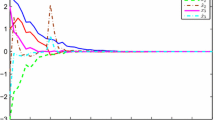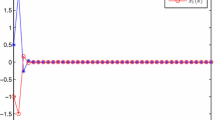Abstract
In this paper, a finite-time state feedback structure is designed for neural networks with time-varying delays and disturbances. Firstly, finite-time state estimators and finite-time controllers are designed for neural networks to form combined finite-time state feedback structures. Secondly, closed-loop systems composed of neural network systems and estimation error systems are obtained. Then, based on the Lyapunov stability theory, the finite-time stability theory and LMIs technology, finite-time bounded conditions of closed-loop systems are obtained. Finally, the validity of the obtained results is verified by two examples.



















Similar content being viewed by others
References
Huang L, Xia Y, Huang L, Zhang S (2021) Two matrix-type projection neural networks for matrix-valued optimization with application to image restoration. Neural Process Lett 53:1685–1707
Liu Q, Wang J (2013) A one-layer projection neural network for nonsmooth optimization subject to linear equalities and bound constraints. IEEE Trans Neural Netw Learn Syst 24(5):812–824
Xia Z, Liu Y, Wang J (2022) A collaborative neurodynamic approach to distributed global optimization. IEEE Trans Syst Man Cybern Syst 53:1–11
Li X, Wang J, Kwong S (2022) Hash bit selection via collaborative neurodynamic optimization with discrete Hopfield networks. IEEE Trans Neural Netw Learn Syst 33(10):5116–5124
Xia Z, Liu Y, Lu J, Cao J, Rutkowski L (2021) Penalty method for constrained distributed quaternion-variable optimization. IEEE Trans Cybern 51(11):5631–5636
Yan Z, Wang J (2015) Nonlinear model predictive control based on collective neurodynamic optimization. IEEE Trans Neural Netw Learn Syst 26(4):840–850
Shahamiri SR, Salim SSB (2014) A multi-views multi-learners approach towards dysarthric speech recognition using multi-nets artificial neural networks. IEEE Trans Neural Syst Rehabil Eng 22(5):1053–1063
Jiang Y, Wang Y, Miao Z, Na J, Zhao Z, Yang C (2022) Composite-learning-based adaptive neural control for dual-arm robots with relative motion. IEEE Trans Neural Netw Learn Syst 33(3):1010–1021
Zhang X-M, Han Q-L (2011) Global asymptotic stability for a class of generalized neural networks with interval time-varying delays. IEEE Trans Neural Netw 22(8):1180–1192
Zhang B, Lam J, Xu S (2015) Stability analysis of distributed delay neural networks based on relaxed Lyapunov–Krasovskii functionals. IEEE Trans Neural Netw Learn Syst 26(7):1480–1492
Li X, Li F, Zhang X, Yang C, Gui W (2018) Exponential stability analysis for delayed semi-Markovian recurrent neural networks: a homogeneous polynomial approach. IEEE Trans Neural Netw Learn Syst 29(12):6374–6384
Liu P, Wang J, Guo Z (2021) Multiple and complete stability of recurrent neural networks with sinusoidal activation function. IEEE Trans Neural Netw Learn Syst 32(1):229–240
Ge C, Hua C, Guan X (2014) New delay-dependent stability criteria for neural networks with time-varying delay using delay-decomposition approach. IEEE Trans Neural Netw Learn Syst 25(7):1378–1383
Lian H-H, Xiao S-P, Yan H, Yang F, Zeng H-B (2021) Dissipativity analysis for neural networks with time-varying delays via a delay-product-type Lyapunov functional approach. IEEE Trans Neural Netw Learn Syst 32(3):975–984
Liu P, Zeng Z, Wang J (2018) Multistability of recurrent neural networks with nonmonotonic activation functions and unbounded time-varying delays. IEEE Trans Neural Netw Learn Syst 29(7):3000–3010
Kobayashi M (2020) Noise robust projection rule for hyperbolic Hopfield neural networks. IEEE Trans Neural Netw Learn Syst 31(1):352–356
Liu S, Wang Z, Chen Y, Wei G (2020) Dynamic event-based state estimation for delayed artificial neural networks with multiplicative noises: a gain-scheduled approach. Neural Netw 132:211–219
Wen S, Zeng Z, Huang T, Yu X (2014) Noise cancellation of memristive neural networks. Neural Netw 60:74–83
Xue B, Li S, Zhu Q (2012) Moving horizon state estimation for networked control systems with multiple packet dropouts. IEEE Trans Autom Control 57(9):2360–2366
Khan N, Irfan Khattak M, Gu D (2012) Robust state estimation and its application to spacecraft control. Automatica 48(12):3142–3150
Viegas D, Batista P, Oliveira P, Silvestre C, Chen CP (2015) Distributed state estimation for linear multi-agent systems with time-varying measurement topology. Automatica 54:72–79
Wang LY, Lin F, Chen W (2018) Controllability, observability, and integrated state estimation and control of networked battery systems. IEEE Trans Control Syst Technol 26(5):1699–1710
Zanma T, Ohtsuka T, Liu K-Z (2020) Set-based state estimation in quantized state feedback control systems with quantized measurements. IEEE Trans Control Syst Technol 28(2):550–557
Hu Q, Jiang B, Zhang Y (2019) Observer-based output feedback attitude stabilization for spacecraft with finite-time convergence. IEEE Trans Control Syst Technol 27(2):781–789
Amato F, Darouach M, De Tommasi G (2017) Finite-time stabilizability, detectability, and dynamic output feedback finite-time stabilization of linear systems. IEEE Trans Autom Control 62(12):6521–6528
Wang X, Li Z, Yu X, He Z (2022) Adaptive smooth disturbance observer-based fast finite-time attitude tracking control of a small unmanned helicopter. J Frankl Inst 359(11):5322–5340
Fang L, Ding S, Ma L, Zhu D (2022) Finite-time state-feedback control for a class of stochastic constrained nonlinear systems. J Frankl Inst 359:7415–7437
Lin W-J, He Y, Zhang C-K, Wu M (2020) Stochastic finite-time \(H_{\infty }\) state estimation for discrete-time semi-Markovian jump neural networks with time-varying delays. IEEE Trans Neural Netw Learn Syst 31(12):5456–5467
Song J, He S (2015) Robust finite-time \(H_{\infty }\) control for one-sided Lipschitz nonlinear systems via state feedback and output feedback. J Frankl Inst 352(8):3250–3266 (special Issue on Advances in Nonlinear Dynamics and Control)
Wang Z, Xu Y, Lu R, Peng H (2017) Finite-time state estimation for coupled Markovian neural networks with sensor nonlinearities. IEEE Trans Neural Netw Learn Syst 28(3):630–638
Liu X, Su H, Chen MZQ (2016) A switching approach to designing finite-time synchronization controllers of coupled neural networks. IEEE Trans Neural Netw Learn Syst 27(2):471–482
Wang L, Wang Z, Wei G, Alsaadi FE (2018) Finite-time state estimation for recurrent delayed neural networks with component-based event-triggering protocol. IEEE Trans Neural Netw Learn Syst 29(4):1046–1057
Liu Y, Wang Z, Liu X (2006) Global exponential stability of generalized recurrent neural networks with discrete and distributed delays. Neural Netw 19(5):667–675
Wang L, Wang Z, Wei G, Alsaadi FE (2018) Finite-time state estimation for recurrent delayed neural networks with component-based event-triggering protocol. IEEE Trans Neural Netw Learn Syst 29(4):1046–1057
ElBsat MN, Yaz EE (2013) Robust and resilient finite-time bounded control of discrete-time uncertain nonlinear systems. Automatica 49(7):2292–2296
Wang Z, Fang J, Liu X (2008) Global stability of stochastic high-order neural networks with discrete and distributed delays. Chaos Solitons Fract 36(2):388–396
Jiang X, Han Q-L, Yu X (2005) Stability criteria for linear discrete-time systems with interval-like time-varying delay, In: Proceedings of the 2005, American Control Conference, vol 4, pp 2817–2822
Lin W-J, Han Q-L, Zhang X-M, Yu J (2022) Reachable set synthesis of Markov jump systems with time-varying delays and mismatched modes. IEEE Trans Circuits Syst II Express Briefs 69(4):2186–2190
Yao D-Y, Ren H-R, Li P-S, Zhou Q (2018) Sliding mode output-feedback control of discrete-time Markov jump systems using singular system method. J Frankl Inst 355(13):5576–5591
Acknowledgements
This work is partially supported by National Natural Science Foundation of China (61673257) and the Fundamental Research Funds for the Central Universities (22D110423).
Author information
Authors and Affiliations
Contributions
YT put forward the conceptualization thought, compiled the software and wrote the main manuscript text. ZR put forward the Methodology. DT verified the control method in the manuscript. ZF verified the control method in the manuscript. XF verified the control method in the manuscript. All authors reviewed the manuscript.
Corresponding author
Additional information
Publisher's Note
Springer Nature remains neutral with regard to jurisdictional claims in published maps and institutional affiliations.
Rights and permissions
Springer Nature or its licensor (e.g. a society or other partner) holds exclusive rights to this article under a publishing agreement with the author(s) or other rightsholder(s); author self-archiving of the accepted manuscript version of this article is solely governed by the terms of such publishing agreement and applicable law.
About this article
Cite this article
Tong, Y., Ren, Z., Tong, D. et al. Combined Finite-Time State Feedback Design for Discrete-Time Neural Networks with Time-Varying Delays and Disturbances. Neural Process Lett 55, 7907–7931 (2023). https://doi.org/10.1007/s11063-023-11289-y
Accepted:
Published:
Issue Date:
DOI: https://doi.org/10.1007/s11063-023-11289-y




